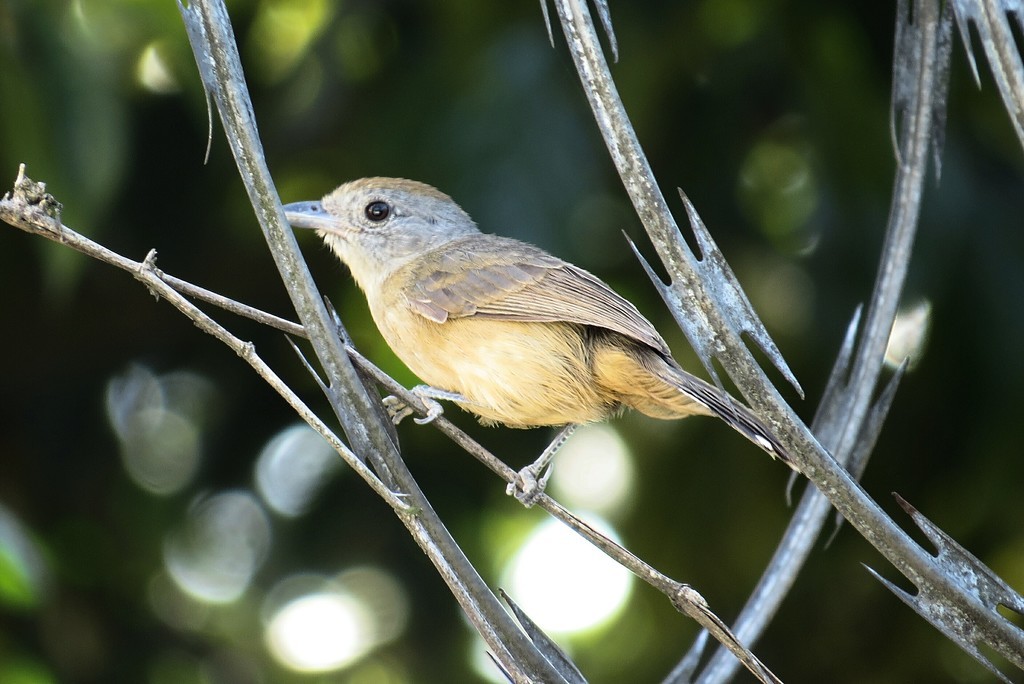Variable Antshrike
A species of Typical antshrikes Scientific name : Thamnophilus caerulescens Genus : Typical antshrikes
Variable Antshrike, A species of Typical antshrikes
Botanical name: Thamnophilus caerulescens
Genus: Typical antshrikes
Content
Description General Info
 Photo By Murilo Nascimento , used under CC-BY-SA-4.0 /Cropped and compressed from original
Photo By Murilo Nascimento , used under CC-BY-SA-4.0 /Cropped and compressed from original Description
The variable antshrike is a thickset bird with a total length of approximately 14–16 cm (5.5–6.3 in). The male has black wings with grey edging to the remiges (sometimes very narrow, and barely visible in the subspecies where the males are primarily black), and white wing-bars that may appear spotty, especially on the lesser wing coverts. The tail is black with white tips (best visible from below). In the eastern, central and southern subspecies, the chest and most of the head are grey, the back is grey with variable amounts of black (may be almost entirely black), a semi-concealed white interscapular patch, and the crown is black (black crown reduced in far north-eastern Brazil). The variation in the colour of the belly and crissum (the undertail coverts surrounding the cloaca) is highly complex, ranging from white in some subspecies, over grey in others, to deep cinnamon. The male of the western subspecies melanochrous from the Andes of Peru is strikingly different, being overall black except for the white in its wings and tail. The male of the subspecies aspersiventer of the Andes in north-western Bolivia and adjacent Peru approaches melanochrous in colour, but has dense white barring to the belly. Females are equally variable. In most of this species range, their wings are blackish-brown with rufescent edging to the remiges, and white or buff wing-bars (often appears rather spotty). In north-eastern Brazil, however, the wing-bars are greatly reduced, and, in the population in Ceará, to the extent where it essentially is lacking. The tail resembles that of the males, but is often more brownish. The underparts are rich orange-cinnamon, in a few subspecies extending as far up as the chest, but in most the chest is pale brownish or grey. The back is brown and the head is pure grey or pale grey tinged brown, while most subspecies have a brown crown, which, however, is black in parts of central Brazil and in the Andean subspecies melanochrous and aspersiventer. Both sexes of all subspecies have grey legs and a stubby bill that is grey below, blackish above. Some subspecies are easily confused with the slaty antshrikes, but these differ consistently in their broad white edging to the tertials. 
Size
16 cm
Nest Placement
Shrub
Feeding Habits
Variable Antshrike primarily consumes a diverse range of insects and arthropods, such as moths, grasshoppers, and beetles, along with spiders, seeds, and fruit. Individuals forage actively from ground to midstory, employing various methods like gleaning and hover-gleaning, adapting their pace to cover areas thoroughly. They may also participate in mixed-species flocks or follow army ants to find food.
Habitat
Variable Antshrike's habitat spans diverse woodlands in eastern and southern South America, from humid forest edges to arid thickets. Favoring dense vegetation, they occupy forest peripheries, vine-covered areas, and second-growth forests up to 3000 meters in the Andes. They thrive in understorey and mid-storey strata, often near watercourses and swamps.
Dite type
Insectivorous
General Info
Feeding Habits
Bird food type
Behavior
In terms of behavior, this is a typical Thamnophilus antshrike. It is generally found singly or in pairs at low levels, often within dense undergrowth. Consequently, it can often be difficult to see it well. It feeds primarily on insects and other arthropods. Seeds and fruits have also been reported. While foraging, it is regularly seen "dipping" its tail and flicking its wings. Breeding is seasonal, but exact timing depends on the region. The nest is a woven cup, generally placed rather low. Both sexes incubate the 2-3 eggs. In southeastern Brazil, breeding begins in October and continues through January. While predation is often the cause of nest failure, pairs can renest fairly rapidly and can also have more than one successful nest each season. Also, food abundance was shown, experimentally, to influence several measures of reproductive effort, including clutch size. 
Distribution Area
The variable antshrike is found widely in eastern and southern Brazil, with disjunct populations in Ceará, Pernambuco and Alagoas. From southern Brazil, its range extends through Uruguay, Paraguay, northern Argentina, Bolivia, and along the eastern slope of the Andes in Peru, as far north as the Amazonas Region. It occurs in a wide range of densely to lightly wooded habitats, ranging from the edge of humid forest to arid woodland. In large parts of its range it can be found in lowlands, but it is primarily found in foothills in north-eastern Brazil, and is restricted to highlands up to 2600 meters (8500 ft), locally to 3000 m (9800 ft), throughout a large part of its Andean range. 
Species Status
Not globally threatened.
Scientific Classification
Phylum
Chordates Class
Birds Order
Perching birds Family
Antbirds Genus
Typical antshrikes Species
Variable Antshrike